The object of pride of any gardener, both professional and novice amateur, are the plants, striking with their beauty and unusualness, planted on the site. The most attractive plants with confidence include jasmine bushes. The aroma of this flower is familiar to everyone since childhood – the sweet-exotic smell makes your head spin, fills everything around with a delicious fragrance. Spreading bushes with white flowers in the shape of stars never cease to amaze with their indescribable beauty.
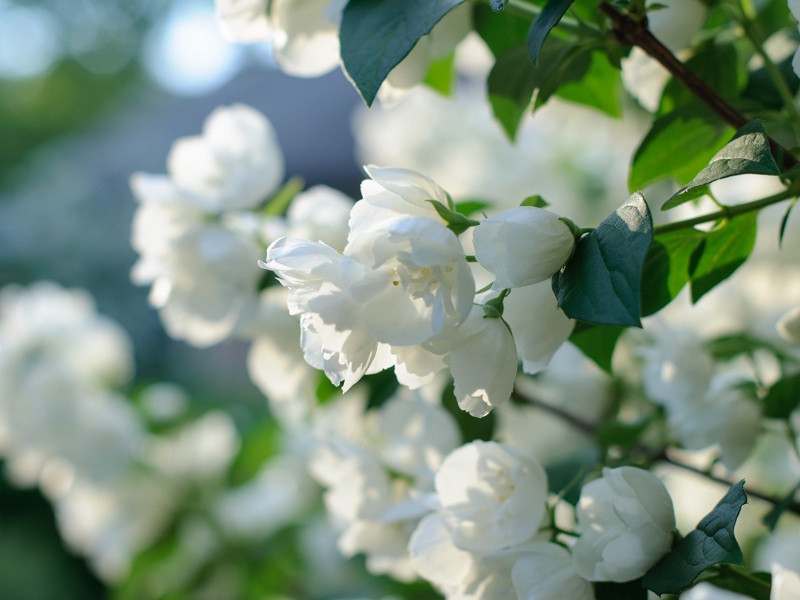
It is interesting! If you turn to history, it can be noted that the wondrous plant got its name in honor of the son of Cleopatra herself, who loved various incense and fragrant flowers. In the old days of young shoots made pipes for smoking, which were called “chubuk”. The people call jasmine bushes “Chubushnik”. Hardwood shrub and now used for the production of musical instruments such as flute, pipe, waxwing.
Varieties of jasmine varieties
Among the huge number of varieties of ornamental shrubs, breeders distinguish the main varieties, which include:
- Common coronet jasmine with large inflorescences and bright green foliage. During the flowering period, flowers emit a strong fragrance. The size of an adult bush reaches a height of about three meters.
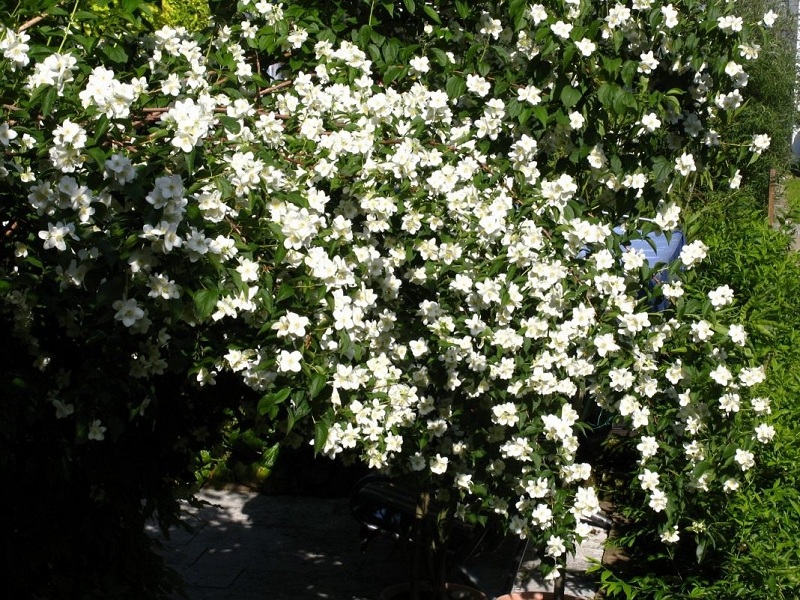
- Small-leaved jasmine is distinguished by its compactness (not more than a meter), small leaves and double flowers. Flowers exude a delicate sweetish aroma, reminiscent of the smell of ripe strawberries.
- Fluffy jasmine blooms much later than their counterparts. The flowers are not white, but rather creamy, almost odorless. And if they smell, it is very gentle, barely perceptible. Bushes high, above 4 meters, have sprawling branches and rich foliage. Virtually all other varieties of this ornamental plant are hybrids.
When choosing both the main type of jasmine and its hybrids, it is worth carefully studying all its characteristics and the best growing conditions. All this will further allow you to admire the indescribable beauty and inhale the wondrous fragrance of flowers, and caring for the plant will not cause any particular difficulties and troubles.

Preparing a site for planting a plant (ground)
To the ground, jasmine bushes are almost demanding. However, the plant will be able to please you with abundant flowering, only growing on fertile soil. When planting should take into account the fact that Jasmine does not like stagnant moisture. In this regard, when planting young shoots, select the highest areas or make artificial drainage by mixing sand, crushed stone, gravel, and broken brick fragments.
When planting jasmine shoots should prepare a hole about half a meter deep, fill with fertile soil and add fertilizer. The root system should not be buried too deep in the ground. It is enough to sprinkle with earth for 3-4 cm. Abundant watering and tamping of the soil around the planted plants are required!
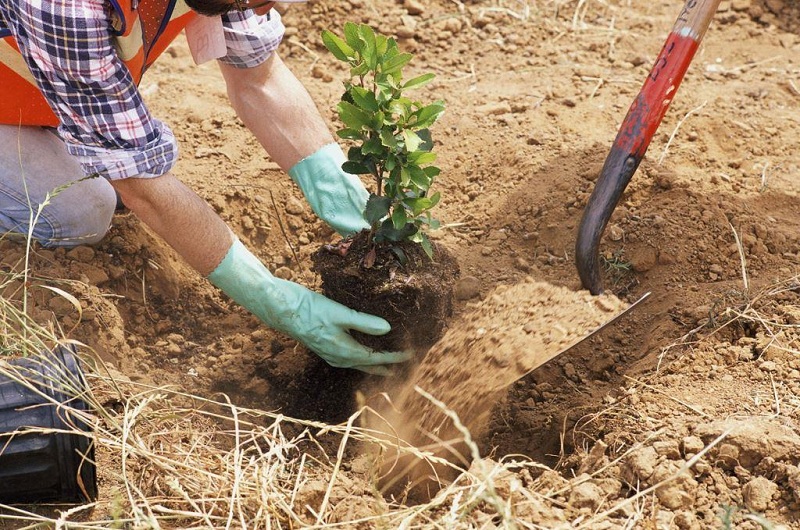
Jasmine planting dates
For planting young bushes in the open ground, the period of the year is suitable when frost and drought are almost impossible. This may be late spring or early autumn. It is possible to propagate a plant with the help of branches or cuttings only after the end of flowering (from July to November).
Fertilizer and dressing ornamental bushes
Part of the required fertilizer is applied during planting. Feed the bush next time is only a year after planting – otherwise, the young and still fragile root system can be badly damaged and even “burn.”
For garden jasmine both mineral, and organic fertilizers are suitable. When choosing a mineral dressing, 15 g of urea, 30 g of superphosphate and 15 g of potassium sulfate are mixed in a bucket of water. This solution is enough to feed one large or two young bushes.
Those who prefer organic fertilizers should be diluted with the slurry in cold water at a ratio of 1:10 and feed the plant before flowering. A good growth stimulant for jasmine bushes is wood ash. Taking 100 grams of ash and adding directly to the soil under the plant, you will provide abundant flowering and accelerate the growth of the bush.

Almost all year round (except for winter), weed and loosen the soil near the jasmine. A good solution would be to mulch the ground around the trunk with leaf humus or dried compost. This will preserve moisture and improve air exchange at the root system.
Pruning and shaping the bush
Garden jasmine often has an irregular (asymmetrical) shape. To give a neat and well-groomed appearance, the plant should be regularly formative pruned.

Here are some basic rules for correct pruning:
- Formative pruning should be done in spring when the plant is still in a vegetative state (in the so-called “hibernation”);
- Long, protruding branches can be trimmed completely, and small shoots shortened only by half.
- To jasmine pleased abundant flowering, during the formation of the bush should be cut off all empty branches without buds.
- An annual shrub should be thinned, leaving only the strongest branches and shoots.
- After the jasmine has faded, you should remove all dried flowers, otherwise, the plant will disappear all the attractive appearance.

Preparing the plant for frost
If an adult shrub plant is able to withstand cold and frost without much hassle, then a young jasmine bush should be taken care of even before the first snow.
- Before the first frost around the plant, carefully (not too deeply so as not to damage the roots) dig up the ground, thereby giving additional oxygen to the root system and destroying excess weeds.
- To protect against frost around the trunk should be filled with a thin layer of pine needles or compost. This will keep the young jasmine roots loose in summer.
- In regions where the probability of severe frosts is high, young bushes wrap them up completely with a special covering material and tie them up not too tightly but firmly with a rope (thin wire).
Shrub reproduction
To multiply the bushes of garden jasmine in the following ways:
- Seeds.This type of breeding is the longest in time. Sowing the seeds in the open ground before the onset of frost, in the spring you can wait only for the first shoots. Mature shrub, capable of pleasing you with full bloom, will appear only after 7-8 years. But the seedlings grown from seeds are the most hardened and resistant to pests and diseases.
- Cuttings. Cropped cuttings about 5 cm long in early summer should be rooted in the nutrient mixture. This mixture can be prepared by mixing in equal parts peat with sand. After rooting, they are transplanted into the open ground and covered for a while with a transparent container (a cut plastic bottle or glass jar will do).

- Shoots. In the spring, during pruning, the strongest shoots are not removed but left for further growth. Already next spring they are being dug up, trying not to damage the mother bush, and transplanted to a new permanent growth place.
- Layering. Choosing the largest branch (escape), it is bent to the ground in a previously made recess and sprinkled on top of the ground. After 6-7 weeks, you can see that the layers began to branch. And in early autumn a young bush can be planted from the mother bush to a new place.
- The division of the bush. Not the most common, and even more secure method of reproduction is sometimes used by the most experienced gardeners. The division of the root system is recommended in the autumn when the plant is ready for wintering.
Diseases and pests. Fighting them
The most common pests of jasmine bushes are leaf weevil, spider mites, and aphids. Signs of damage to plants can be drying and yellowing out of season leaves, as well as the presence on the foliage, inflorescences, and stem of a thin web.
You can get rid of pests by treating the bush with a solution of household soap or insecticidal preparations. Even pouring hot water over the plant helps.

Jasmine belongs to the plants that are most resistant to various diseases. Only because of the lack of fertilizers and nutrients in the soil the plant can grow too slowly and practically not flowering. To fix this is easy – it is worth adding mineral complex fertilizer to the soil. The effect will not be long in coming – next spring you will be able to enjoy the beauty of flowering shrubs.
Landscape location
When planting both solitary and several jasmine bushes, you should consider the place and landscape composition. High varieties of jasmine are usually planted in the garden alone, but low-growing varieties can be planted in such a way that the bushes served as a hedge. Use decorative bushes and as a background for flower beds. Not bad against the blossoming white clusters of jasmine will look pink peonies or phlox. Cut branches of flowering jasmine are used for making bouquets.
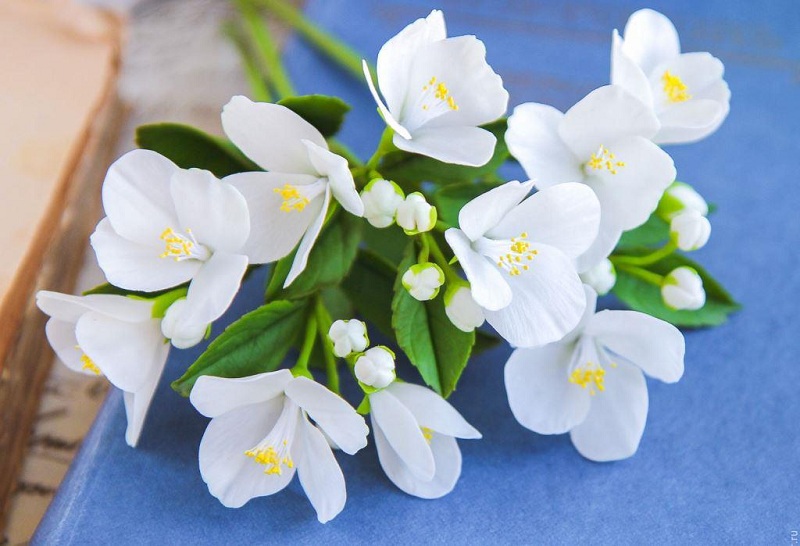
Beneficial features
The jasmine bush is not only an ornament of a personal plot – it can greatly enhance your health. The recently blossomed flowers contain a large number of essential oils that have a beneficial effect on human well-being. Herbalists and healers from the unborn buds prepare decoctions and infusions to improve digestion and strengthen the immune system.
If you follow all the few rules of planting and care, jasmine will delight its owners for years with the indescribable magic of its fragrant flowers!
You may also like Edible Flowers
Tags: Care, Cottage, Country cottage, Cultivation of Flowers, Farmland, Floriculture, Flower Garden, Garden Decor, Gardening Garden, Jasmine Jasmine, plant, Planting, Shrub Jasmine
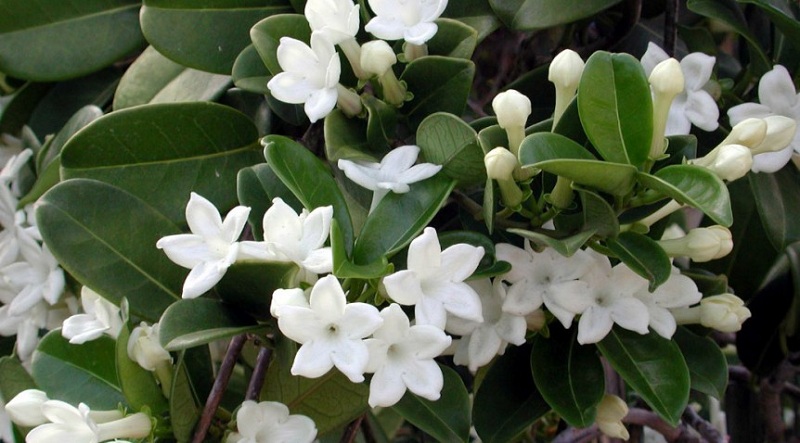



Leave a Reply